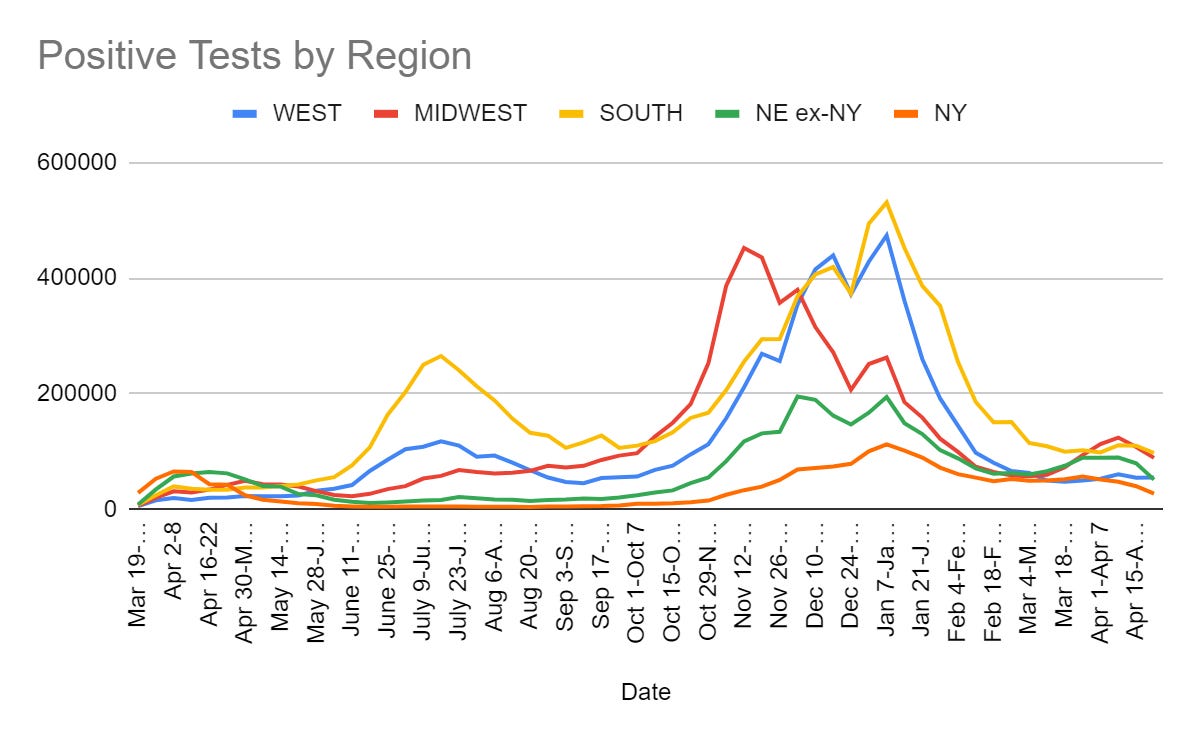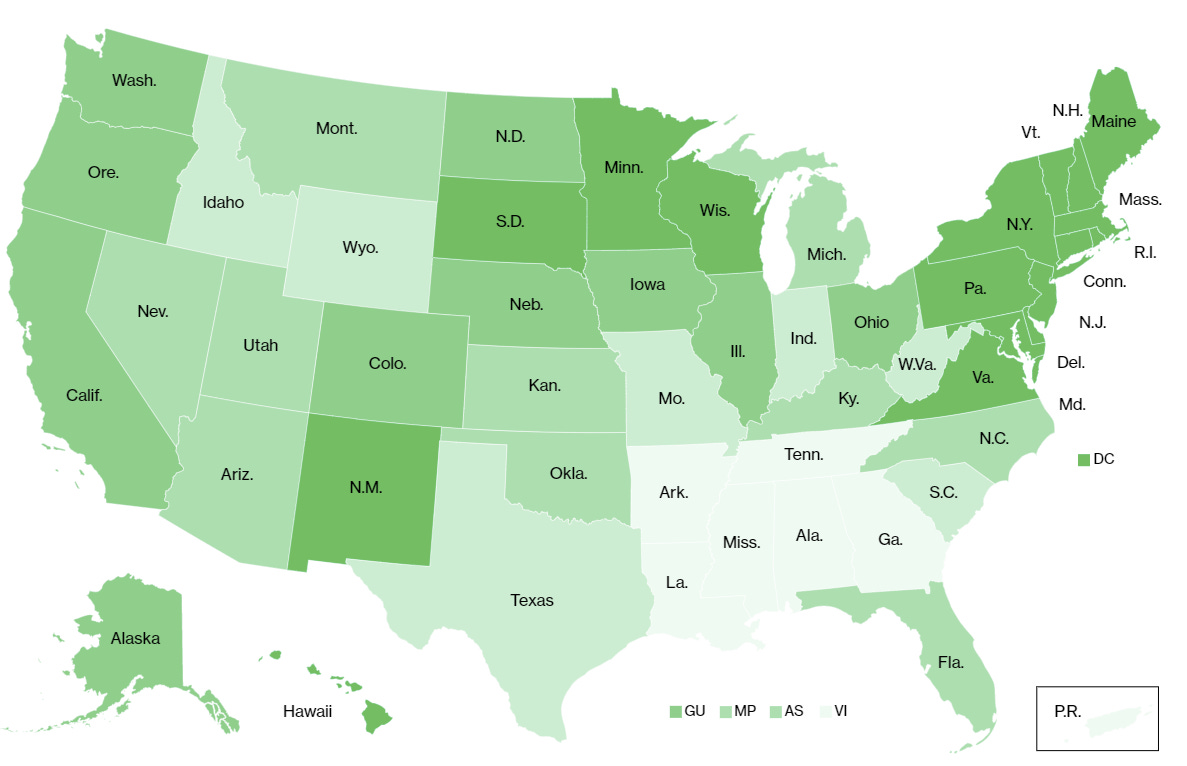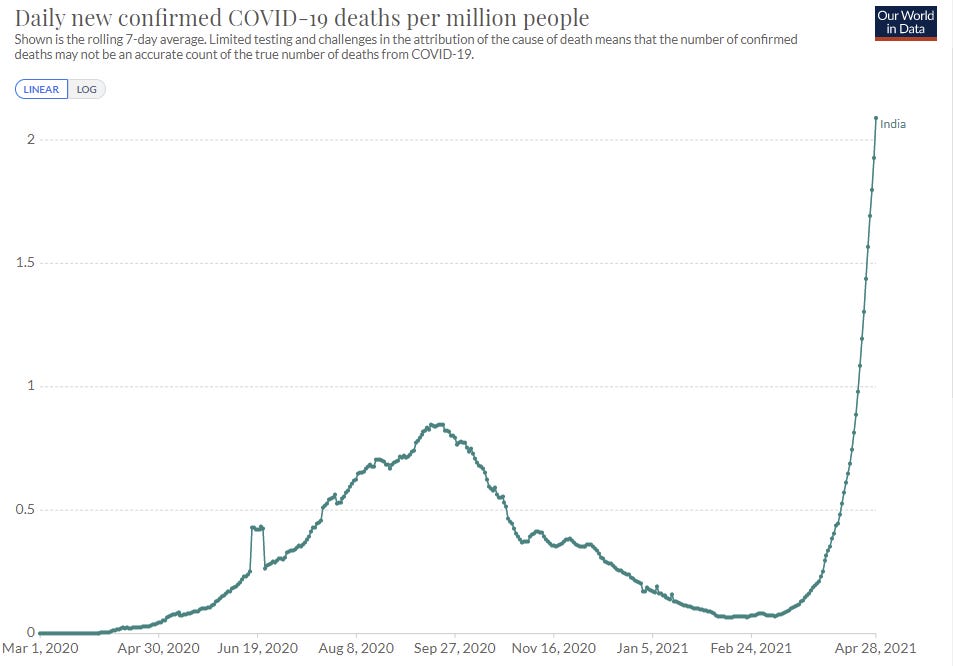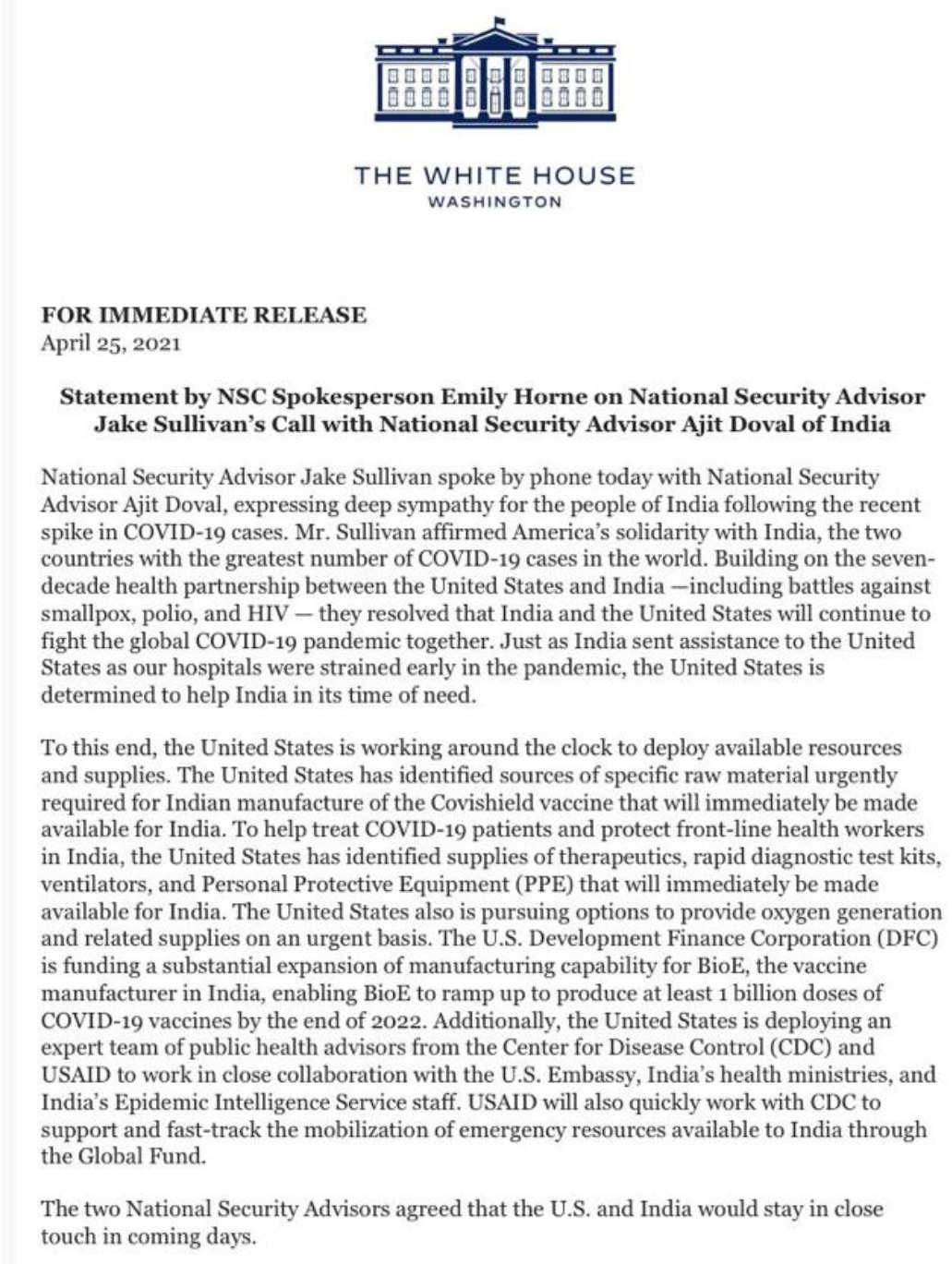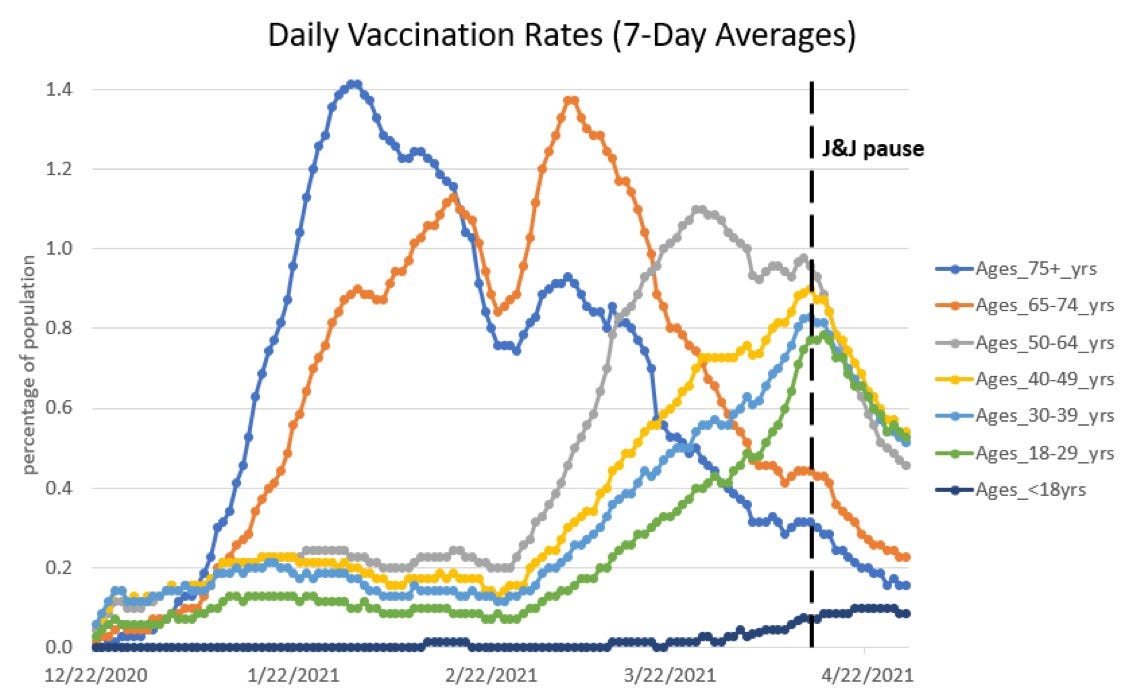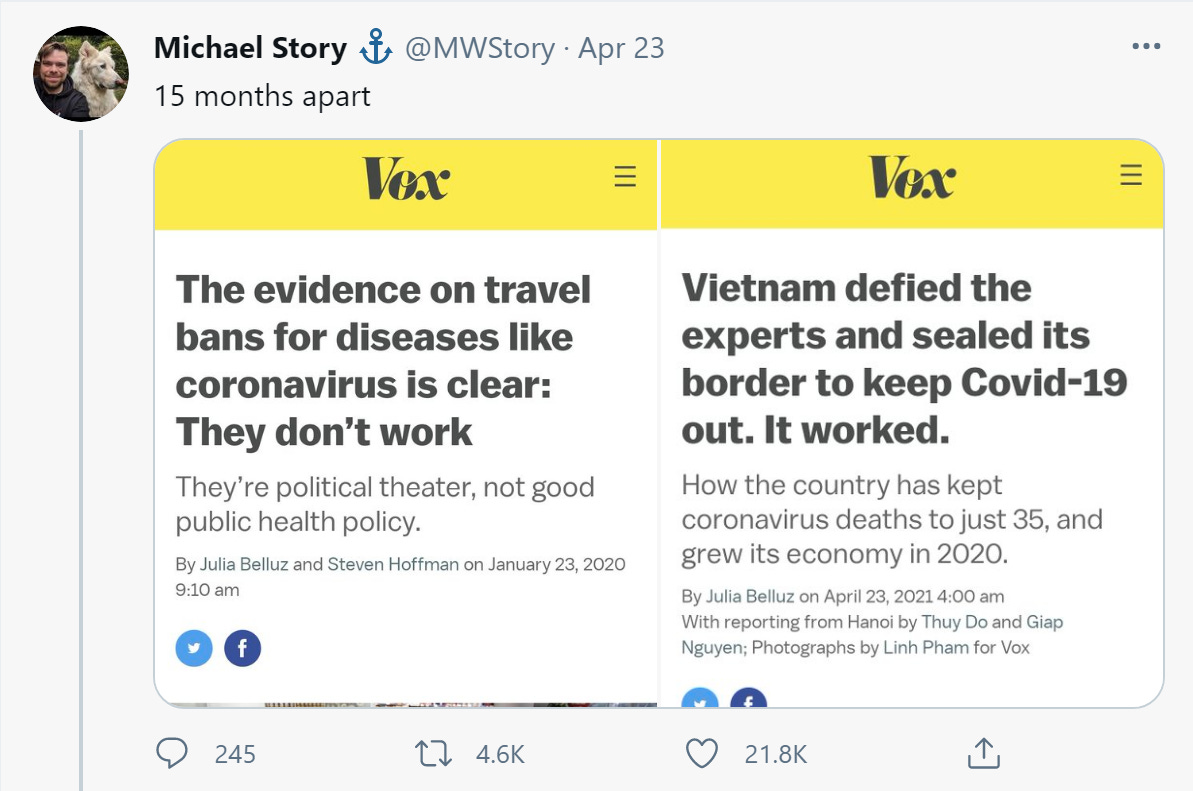Covid 4/29: Vaccination Slowdown
Compared to expectations, excluding inevitable self-inflicted cratering of our vaccination rate, this was mostly a best realistic case scenario week. Johnson & Johnson was unpaused. India’s rate of case increases probably slowed down (they’re maxed out on testing capacity so it’s hard to know for sure). Biden seemed to come around to providing meaningful help to India and the world, at least to some extent.
Most of all, cases in America were down a lot, and it’s now clear that things are steadily improving. Unless something changes, we’re going to beat this thing at least in a large portion of the country, and do so on schedule.
The decline looks really bad though. Like the situation in India, it’s Malcom Reynolds-level worse than you know. When you look at first doses only, the lines are going straight down. If they go all the way to zero, many states and local areas won’t get to herd immunity from the vaccine.
Let’s run the numbers.
The Numbers
Predictions
Prediction from last week: Positivity rate of 5.1% (down 0.2%) and deaths decline by 4%.
Result:
Once again, Washington Post, your numbers don’t make sense together, but this is still clearly a big miss. 4.4% positivity rate is amazingly great in context. Johns Hopkins has the positivity rate declining from 4.7% to 3.9%. It’s worth noting that this ties the all-time low by their metrics.
As always, there’s the worry this ‘got ahead of ourselves’ somewhat, but I don’t think that’s the case. I think it’s more likely we’re making rapid progress, especially in the areas with higher rates of vaccinations.
Prediction for next week: Positivity rate of 3.9% (down 0.5%) and deaths decline by 6%.
Deaths
DateWESTMIDWESTSOUTHNORTHEASTTOTALMar 11-Mar 1714921010321714027121Mar 18-Mar 241823957289512946969Mar 25-Mar 311445976256412626247Apr 1-Apr 71098867178911604914Apr 8-Apr 1410701037162111454873Apr 15-Apr 21883987174711684785Apr 22-Apr 287521173160911104644
I looked for an explanation for the jump in the Midwest, but there does not seem to be a data anomaly. It may be somewhat random, but it’s likely the delayed result of the local surge in cases in early April before things stabilized. While looking for a potential issue, I instead noticed that West Virginia reported -159 deaths one day, which I changed to 0, bringing their weekly total in line with expectations.
Overall the result is another small drop, which matches expectations. We should see progress accelerate from here within the month.
Cases
DateWESTMIDWESTSOUTHNORTHEASTMar 11-Mar 1749,69659,881109,141115,893Mar 18-Mar 2447,92172,81099,568127,421Mar 25-Mar 3149,66993,690102,134145,933Apr 1-Apr 752,891112,84898,390140,739Apr 8-Apr 1460,693124,161110,995137,213Apr 15-Apr 2154,778107,700110,160119,542Apr 22-Apr 2854,88788,97397,48278,442
For another look, here is the monthly Polimath summary by state.
The west stalled out, but the improvement elsewhere was dramatic, especially in the Northeast. The Northeast started off unimpressively on the vaccination front, but now has the best vaccine coverage of any region, likely because the limiting factor is transforming from logistical issues or supply into willingness to take the vaccine. It makes sense that hesitancy is at its lowest in the Northeast, and it’s likely this is now paying off.
I worry that the South, and some other areas with similarly high vaccine hesitancy, will stall out at a place that still requires a lot of preventative action to contain the virus. If that happens, will such action be sustained?
Vaccinations
Whoops.
This map now looks similar enough to the blue vs. red tribe map that the exceptions like the Dakotas stand out quite a bit. Presumably conditions there were bad enough that hesitancy is lower than it would otherwise be. The map also makes it that much more surprising that Georgia voted the way it did.
What’s clear is that vaccinations are cratering, and it is due to the massively destructive, completely needless pause in the J&J vaccine. The damage is done, and resuming isn’t going to reverse that much of it. See the section Pausing Vaccines For No Reason Still Doesn’t Work for more discussion of that.
The question is whether we still have enough momentum to get to the finish line. If the above graph was proportional to first doses, I’d say strongly yes, we’re going to be fine. Unfortunately, the declines are much more pronounced in first doses and it seems plausible we will stall out not too far from where we are now.
If that happens, will it be enough? Or will we have essentially destroyed normal life in substantial parts of the United States indefinitely because of one death and six blood clots? It seems clear that the Northeast and other low-hesitancy areas will make it. It is not at all clear that the high-hesitancy states and areas are still on track to make it.
India
The straight line up continues, but there was never much hope that things would suddenly reverse. The best case scenario was that we’d see this and it would represent a genuine slowdown in case growth, which could then level off within a few weeks. The share of positive tests is also increasing more slowly than before, so I think it’s probably a genuine improvement in the sense that things aren’t getting worse as fast as one would have expected.
They’re still actively getting worse, though. This might be good news, but that only means the situation is terrible and getting worse, rather than even more terrible and getting even worse faster. It’s a horror show.
Oxygen is running out and the situation is increasingly dire. Without oxygen, a lot more Covid patients die. What happened?
Exponential growth happened. When you’re using half your oxygen capacity (and far more than half your available capacity given industrial needs) you’re less than one doubling away from disaster. Plus all the calculations likely exclude a lot of the people who are buying oxygen privately, and the supplies lost to looting or profiteering.
On top of that, the logistics of distribution are all designed based on lower levels of consumption, so shipping, storage and delivery all have inadequate capacity given current demand, and also there’s uneven distribution between regions as one would expect.
Marginal Revolution links to this update on the situation as of April 23. It’s worth posting the bulk of it:
What are we who are here in America doing about this crisis?
Sarah is lowballing here with hundreds of thousands. We are already sitting on one hundred million doses. If we used a First Doses First approach (in this case, we’d better), and compare the situation with those doses to the one without where marginal cases have no oxygen and no hospital bed, we can likely save over one million lives that way alone. Add in donations of oxygen, our doses of Johnson & Johnson (let’s face it, that ship has sailed here and we don’t need them much anymore, but it’s not too late for India) and all the other raw materials and supplies, along with lifting export controls, and even without the obviously correct push to increase output of vaccines we can still work miracles here. There’s time left to be heroes, and also help ourselves. Or we could choose another path.
It’s not that we’re doing nothing helpful. We’re putting out Official Diplomatic Statements saying that we’re working around the clock and doing everything we can
Which is great, glad we’re doing all that, the thing is that it still excludes the thing we could have done (make more vaccine doses) and the by far most important thing we could do now (ship them our vaccine doses that are sitting on shelves unused). As a result, a lot of people are going to die.
You can say the right things...
But that doesn’t change that Biden’s failure to devote a few billion to getting the world vaccinated is more striking each time he proposes a multi-trillion dollar new spending bill.
It’s one thing to give away the surplus vaccines and capacity you happen to have once you’re finished vaccinating your own country. It’s another to engineer a worldwide solution on purpose rather than incidentally.
The good news is that the pressure has gotten to us, and we’re going to do the right thing. Like classic Americans, we’ll do it after having exhausted all alternatives, and thus we’re still going to delay this to the ‘coming months’ with ‘safety checks.’ Also note that the link here thinks we only have 50 million doses rather than 100 million, but that doesn’t change what we should do with whatever we have. All of this was after fierce internal debate about whether we should guard against a potential vaccine shortage by hoarding vaccines we’ll never approve, or by not exploring the vaccines we haven’t approved for our own use until after we’ve approved them.
John Cochrane points out that another contributing reason we haven’t been able to export vaccines is the issue of liability. In America, we didn’t pay anything like what vaccines were worth let alone pay tiny amounts of money to allow for the manufacturing for massive additional quantities of vaccines, but we did at least give vaccine manufacturers immunity from liability if something went wrong. Places like India don’t extend those protections, so the pharma companies protected themselves by not allowing exports to places where they could be sued into oblivion for things the vaccines didn’t even cause, or things so rare they don’t matter.
As John points out, either the pharma companies are worried about something real, or they aren’t. If they’re worried about a fake problem, then the federal government should indeed assume the liabilities, or it should insist that other countries issue the same waivers. If they’re worried about a real problem, then they really need to do those exact same things, or that’s that. Otherwise, it could plausibly become actively unprofitable to develop vaccines, which is not a place we want to go.
I have a hard time believing liability concerns are a True Objection to the exporting of vaccines. If we offered donations on the basis of a liability waiver, and India said no, that seems like true political (and literal) suicide.
Then again, I can see a world in which the optics of our offer would be the dealbreaker here. That it would look so bad to be ‘demanding protection for our fatcat companies’ or something that it’s simply impossible to ask, and thus we let a million people die. Or, we would hope, India waves the liability issue on its own first, without being asked, but we can’t ask or we’re blameworthy.
We could also be worried about the look of ‘giving up our castoffs’ and giving India the ‘not as good’ vaccines we aren’t willing to approve ourselves, and have to explain why they’re good enough for Indians and not good enough for Americans. Either they’re good vaccines or they’re not, and giving them away puts us in a bind. We’ve already given away a few to Canada and Mexico, so the seal on this might already be broken, but this would be a much bigger spotlight.
The safety concerns could also be legitimate, because we’ve been letting the vaccine sit on the shelf for months. Thus, having already failed to protect anyone in the meantime, we might also have let the vaccines go bad, and we have to verify that this isn’t the case. That could partly justify the current delay, but of course it makes our earlier decisions that much less excusable.
Another problem was that India literally refused to authorize the Pfizer vaccine without a trial done on Indians in India. Pfizer had to withdraw its application. Now that there’s a crisis, India is doing the commonsensical ‘approve anything anyone trustworthy has approved’ approach. When such vaccine nationalism is present, and combined with demands to wave patent protections (which Pfizer already said they wouldn’t enforce) and the implicit demand to do full uncompensated technology transfer that would go well beyond Covid in its implications, one could think that we’ve been put in a difficult spot. But again, the bad behavior of others (and by all accounts, the Modi government has done plenty of not-so-great things across the board) does not excuse your own failure to help the people of the world.
Vaccines Still Work
The CDC is tracking breakthrough infections and deaths, meaning ones that happen post-vaccination. This Slate article summarizes the early findings: that such events do happen but they are extremely rare. Even Eric Topel notes that there are fewer such cases than we would have expected. I did a little work on the original CDC data as of April 20, and got about a 99% reduction in deaths for the fully vaccinated group versus the general population, as measured in deaths per person-day over the last few months. That calculation had to make a few assumptions regarding exactly how everything was being defined and measured, so it’s possible it’s off a bit in either direction, but 99% feels like a reasonable real-world reduction given what we know and all the behavioral changes that happen after vaccination.
Zeynep analyzes an outbreak at a Kentucky nursing home, which included one of those breakthrough deaths, and explains why she thinks it should be seen as encouraging news about vaccinations rather than bad news. One would expect the vaccines to be less effective in that context than overall, as it was pretty much the worst case scenario - older patients whose immune systems no longer work properly, in close indoor quarters for extended periods. Yet the vaccines still worked very well.
As with all vaccine news, what is good versus bad news depends upon your previous epistemic state. If you previously thought vaccines were definitely super duper effective, hearing evidence they are only super effective, but without the duper attached, is bad news. Whereas that’s still great news from the perspective of anyone with bigger doubts who isn’t sure if they’re even super effective, let alone super duper effective. This means that a large portion of the time, what the media says is ‘good news’ is something I view as neutral or bad news, but it is still usually helpful in updating people in the correct direction.
Thread by Natalie Dean about the difficulty of avoiding bias in observational vaccination studies. Vaccinations aren’t given out at random, and people are told to act differently both directly prior to vaccination and after vaccination has taken effect. I worry that such de-biasing efforts are relatively robust in the ‘don’t overestimate vaccines due to selection effects’ direction but much less robust in the ‘don’t underestimate vaccines due to behavioral adjustments’ direction.
If you’re still looking for an appointment, vaccine spotter is this week’s website that might help if you haven’t tried them yet (HT: MR).
Or you can walk into a site, at least in some places, and it’s all good:
Pausing Vaccines For No Reason Still Doesn’t Work
Johnson & Johnson is back. After only 10 days, permission has been given to resume vaccinations. I explicitly said last week I didn’t expect the resumption to happen this quickly, so count me as pleasantly surprised at the news. On reflection, I was likely being too cynical here.
How big is this risk, in the end?
The problem is that the FDA successfully convinced Americans that the Johnson & Johnson vaccine is not safe, with a majority saying it was not even somewhat safe during the pause (WaPo). The question is, how much of that effect does resuming permission undo? Are people taking their queues here assuming the FDA is on the ball (and thus, it becomes safe again once permission is resumed)? Are they largely accepting that ‘safe’ literally means ‘is allowed by the FDA’ because they view such words as performative deference to authority? Or did they get the message that there’s something wrong with J&J in a way that one cannot magically undo by saying ‘never mind’?
Presumably it’s a mix, and time will tell us which of these groups dominate.
Nate Silver points out the obvious, which is that ‘what the “experts” are actually saying’ has remarkably little to do with when people demand that you ‘listen to the experts.’ He lists several examples of such experts, which you can click through to read and say the obvious common sense things. Thing is, ‘listen to experts’ actually means ‘listen to experts who agree with our elite Very Serious Person opinions in the current context.’
This one isn’t by an expert, but is similar, figured this was the best place to put the link.
What was the result? You can see it in the vaccination graph, but you can see it much clearer in the first doses graph:
This definitely passes the ‘you don’t need statistics because check out this chart’ statistics test. Marginal Revolution gives us another look at the same data:
Yeah, there’s no way this is a coincidence.
Youyang Gu looks back on his machine learning projections. Like the Covid Tracking Project, he decided to stop midway through because ‘other people have this handled’ and then our world got much worse, because other people very much did not have this handled. The basic messages are ones you’ve likely heard before. He also looks at his final predictions on returning to normality, and finds we are very much on track.
I mention this here because when you look at his projection, you can see the impact of the J&J suspension very clearly by comparing it to the counterfactual.
He did expect a gradual slowing down of vaccine progress at about this time, but this was a line still going up exactly on schedule suddenly reversing on the spot into a hard decline.
A good thread of dog in a fire memes that are relevant, for those interested.
Long Covid
The big known unknown of Covid has always been long Covid. There’s short term obvious reasons to be scared of Covid, but what about long term impacts? Data was always sparse. Now there’s a (preprint of a) nature paper about the matter that offers more concrete data.
Taken at face value, it looks like Long Covid is a really big deal. This would be the strongest signal yet that you really, really, really don’t want to get Covid even if you’re relatively healthy, and that taking big precautions to avoid it was a reasonable decision given that the vaccines are now here.
This study was in the Veterans Administration, so the population in question was relatively elderly and in relatively poor health. They attempted to find similar controls, but I am profoundly unsatisfied with the methodologies listed here.
They also prove far too much. Almost everything is worse in the Covid group, and the rate of extra deaths is far too big when compared to the number of excess American deaths. In general, if things were this bad, it would show up in tons of other statistics in ways that it simply doesn’t.
My conclusion, after discussion and analysis, is that this study is largely measuring selection effects, and this makes it all but impossible to know how much of the effects are due to Log Covid versus the people who get symptomatic Covid and have that diagnosis confirmed starting out as sicker to begin with.
That does not mean that the Long Covid effect isn’t real. I’m convinced that at least some of this effect is real, but I don’t think we get to update on that much from this study.
What we can update from this study is the evidential value of having had Covid. In important practical senses, if you test positive for Covid, you face the same situation no matter how much of your health issues will be caused by Covid versus revealed by Covid. What matters is you know your expected future health is much poorer across the board. There’s more reason to focus on one’s health, and to prepare for potential trouble.
If you haven’t had Covid yet, there’s a big difference, because it’s still not clear how much you need to be avoiding Covid out of fear of Long Covid. We know the answer is ‘enough to matter’ but magnitude is important, and I sadly do not think this study should update us that much on that question.
In Other News
Inside the pro-vaccination advertisement effort.
The first ad showing grandma hugging everyone seems very good, aligning with the above quote. The second one promising the facts seems less good and more done by committee to look good to Very Serious People, and my guess is it convinced approximately no one.
They settled on the slogan “It’s up to you.” I certainly can’t argue with that in general, but also no one involved believes it. It’s up to you to make the right decision and come to the right conclusions, and we’ll do whatever it takes until you do exactly that. I happen to think that their selected ‘right decision’ is in fact the very right decision on all levels, but I do worry that in an important sense this is a coincidence. We have examples of other cases where the decision wasn’t right, or was socially good but locally harmful, and it’s hard to see much difference in messaging approaches. Hence much of the hesitancy.
This does not sound like a final check designed to discover the truth. It sounds more like it was designed mostly to give the answer they wanted, along with some mix of a desire to see if they’d made some gigantic horrible mistake and a desire to have a plausible story that they checked for that.
It is also exactly what the campaign sounds like to me. When I saw ‘it’s up to you’ I totally, totally interpreted it as ‘it’s optional.’ Otherwise, what’s up to you? And the answer, of course, is that for such people, it’s ‘up to you’ to make the voluntary choice to do the things you’re told to do. That’s how such people think, and how they envision freedom and democracy. It’s an entire authoritarian mindset where everyone is free to do whatever they want but also disobedience is your fault and you should get punished for it.
It’s also what the ad needs to be interpreted as to be successful. They talk about this later on, saying that conservatives need to have their autonomy respected. People aren’t stupid. Either something is optional, and they have a choice, or it isn’t and they don’t. You can try to send both messages but you’ll fail. So yeah, it’s optional. Or at least, for now it’s optional, until it isn’t.
As is their standard operating procedure, the Biden administration then decided instead to ignore all of this respect for those it disagrees with and instead project a superficial message of unity by going with the slogan “We Can Do This.” I wonder how they think that will play out.
Tabarrok responds to Cruz follow-up question on vaccine passports, points out that partly open is worse than completely open, but better than completely closed. Still leaves open the question of whether passports might lead to slower full reopenings rather than faster ones.
The framing here seems exactly right.
Dr. Fauci admits his previous statements in this area were blatant lies (which as we all know are the best kind) and notes that he expects to no longer need this particular untruth soon, but he’s not quite ready to let go of it yet.
Brazilian regulator rejects Sputnik’s application. It looks like they had very good reasons for doing so. The Sputnik vaccine has serious problems, and the data presented has additional serious problems, and either you’re going to have regulations that stop this kind of botched operation from moving forward or you don’t. It’s very reasonable to turn this application down. If I had no alternative options, though, and lived in India or another place where things were looking bad, I would still be fine with getting it and much prefer it to doing nothing. I’d still be surprised if the vaccine wasn’t effective, and I’d still be surprised if it was sufficiently unsafe to make the cost/benefit of taking the vaccine be remotely close. Still, I do understand that these are not the standards we must use, and that to let this slide would be very bad precedent.
This was going around this week, no comment seems necessary:
It is worth noting that there are some comments in the second article that effectively say 'I was wrong, travel bans do work' and we should definitely applaud everyone admitting that.
This MIT paper on ‘guideline to limit indoor airborne transmission’ was also going around this week:
That’s quite the spherical cow you have there. This assumes the absurd conclusion of automatic uniform mixing in indoor spaces, and then concludes that relative location in those spaces doesn’t matter. If my grandmother had wheels she’d be a trolly car.
So of course the media acted responsibly, as they always do.
Of course, as the NY Post shows us this time, it can always get worse:
And then they use this photo:
Then this one:
The actual content of the article notes that the worries about indoor spaces, but for some reason this type of thing is inevitable. All media must post pictures of people outdoors as being irresponsible, because they look scarily like they’re alive and might even be having fun or living life. Unacceptable. Insinuations must take place right away. The public must be warned.
Then, if necessary, fall back on the story that ‘no this is the way you’re supposed to distance, it only works outside.’ Assert that we were never at war with Eastasia, and it was always unsafe in any indoor space regardless of distance.
Meanwhile, we have cross-country runners in mandatory masks. Which certainly isn’t not insane. And YouTube pulls videos for having “disinformation” when they agree with European mask policy instead of American blue tribe mask policy.
And here are the CDC guidelines for camps. If you’re wondering how ‘spend most of our time outdoors’ changes their recommendations compared to those for schools, I’m here to report that the answer is that it doesn’t. There’s a recommendation to shift things to outdoors, but doing so doesn’t change what you have to do, it’s a pure additional obligation. For example, everyone should stay ‘socially distanced’ at all times, except when eating and thus not wearing masks (and often likely indoors), because that needs to be an exception. Outdoor child masking is otherwise fully mandatory. Paranoia over surfaces is unchanged. If you took these recommendations seriously you wouldn’t have a camp worth going to, rendering such rules worse than useless.
Robin Hanson points out some of the dynamics that doom us to always have ‘elites’ saying ‘more must be done’ and calling for more government oversight, and claiming to have the expertise to argue about details they don’t understand while not trying to understand the more important meta-level. He is right that it is important, when arguing details on the margin, to point out that the arguing of details on the margin is not a way to make good policy decisions. Hopefully I’ve found the right balance of pointing this out and not belaboring the point.
See this Zeynep thread for good detailed analysis. Bottom line is that this is trying to make an important point, that in poorly ventilated spaces the virus can build up over time rendering distance insufficient for safety, but is making it in a terribly misleading way.
Not Covid, but how would you know that without breaking the regulations, since the European Union is proposing to regulate Bayes Rule.





